The iPhone 5s Review
by Anand Lal Shimpi on September 17, 2013 9:01 PM EST- Posted in
- Smartphones
- Apple
- Mobile
- iPhone
- iPhone 5S
Display
The iPhone 5s, like the iPhone 5c, retains the same 4-inch Retina Display that was first introduced with the iPhone 5. The 4-inch 16:9 LCD display features a 1136 x 640 resolution, putting it at the low end for most flagship smartphones these days. It was clear from the get-go that a larger display wouldn’t be in the cards for the iPhone 5s. Apple has stuck to its two generation design cadence since the iPhone 3G/3GS days and it had no indication of breaking that trend now, especially with concerns of the mobile upgrade cycle slowing. Recouping investment costs on platform and industrial design are a very important part of making the business work.

Apple is quick to point out that iOS 7 does attempt to make better use of display real estate, but I can’t shake the feeling of being too cramped on the 5s. I’m not advocating that Apple go the route of some of the insanely large displays, but after using the Moto X for the past month I believe there’s a good optimization point somewhere around 4.6 - 4.7”. I firmly believe that Apple will embrace a larger display and branch the iPhone once more, but that time is just not now.
The 5s’ display remains excellent and well calibrated from the factory. In an unusual turn of events, my iPhone 5c sample came with an even better calibrated display than my 5s sample. It's a tradeoff - the 5c panel I had could go way brighter than the 5s panel, but its black levels were also higher. The contrast ratio ended up being very similar between the devices as a result. I've covered the panel lottery in relation to the MacBook Air, but it's good to remember that the same sort of multi-source components exist in mobile as well.
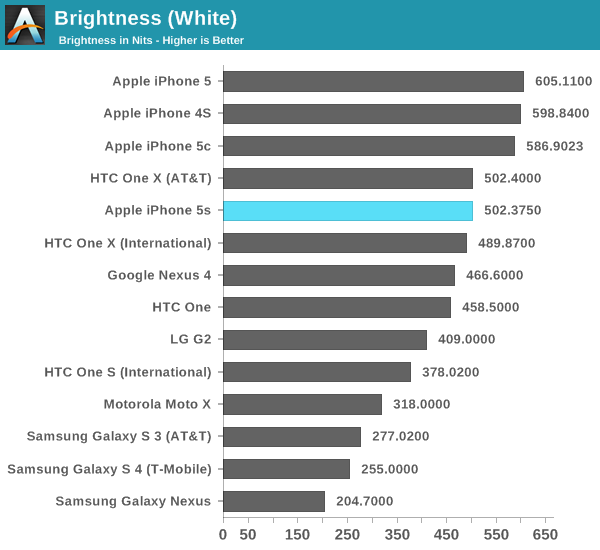
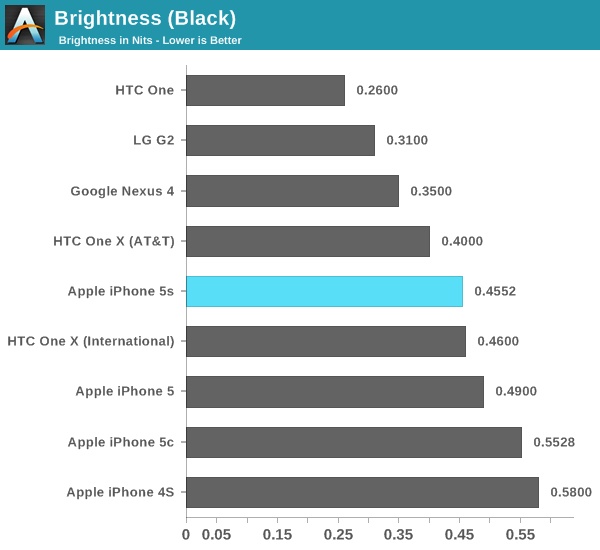
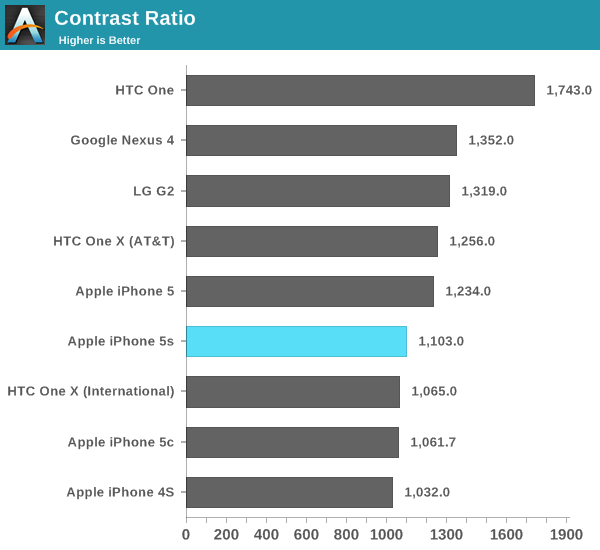
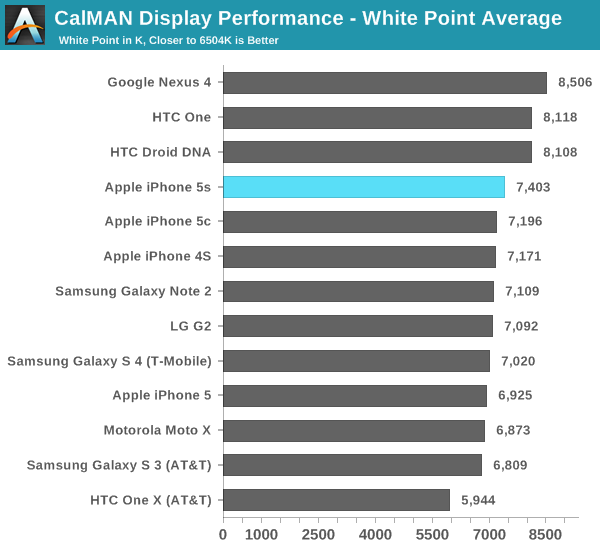

Color accuracy is still excellent just out of the box. Only my iPhone 5c sample did better than the 5s in our color accuracy tests. Grayscale accuracy wasn't as good on my 5s sample however.
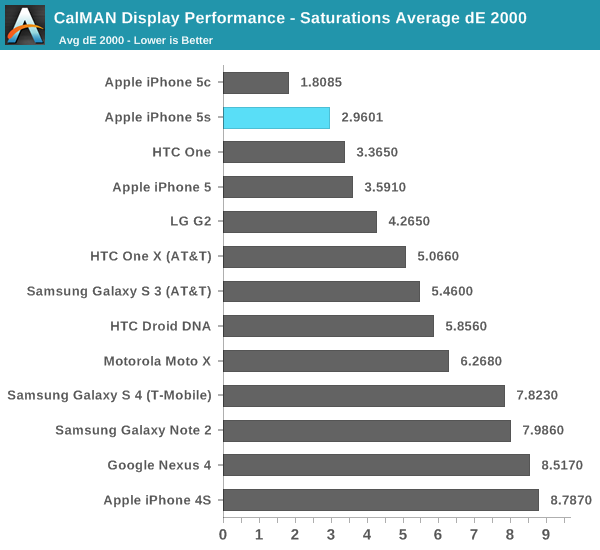
Saturations:

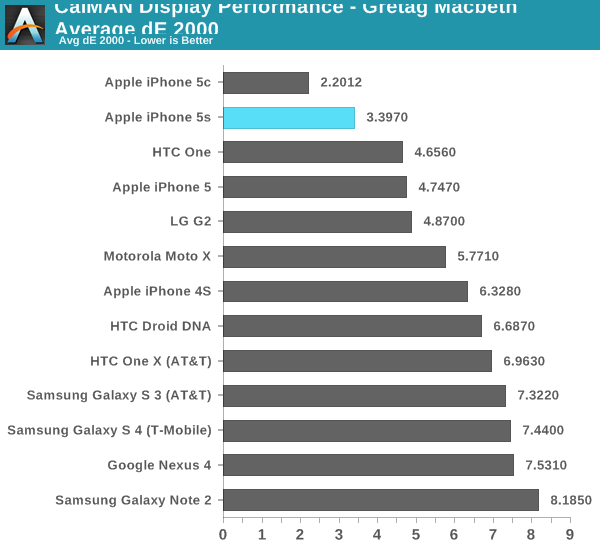
GMB Color Checker:

Cellular
When early PCB shots of the 5s leaked, I remember Brian counting solder pads on the board to figure out if Apple moved to a new Qualcomm baseband solution. Unfortunately his count came out as being the same as the existing MDM9x15 based designs, which ended up what launched. It’s unclear whether or not MDM9x25 was ready in time in order to be integrated into the iPhone 5s design, or if there was some other reason that Apple chose against implementing it here. Regardless of the why, the result is effectively the same cellular capabilities as the iPhone 5.
Apple tells us that the wireless stack in the 5c and 5s is all new, but the lack of LTE-Advanced features like carrier aggregation and Category 4 150Mbps downlink make it likely that we’re looking at a MDM9x15 derivative at best. LTE-A support isn’t an issue at launch, however as Brian mentioned on our mobile show it’s going to quickly become a much needed feature for making efficient use of spectrum and delivering data in the most power efficient way.
The first part is relatively easy to understand. Carrier aggregation gives mobile network operators the ability of combining spectrum across non-contiguous frequency bands to service an area. The resulting increase in spectrum can be used to improve performance and/or support more customers on LTE in areas with limited present day LTE spectrum.
The second part, improving power efficiency, has to do with the same principles of race to sleep that we’ve talked about for years. The faster your network connection, the quicker your modem can transact data and fall back into a lower power sleep state.
The 5s’ omission of LTE-A likely doesn’t have immediate implications, but those who hold onto their devices for a long time will have to deal with the fact that they’re buying at the tail end of a transition to a new group of technologies.
In practice I didn’t notice substantial speed differences between the iPhone 5s, 5c and the original iPhone 5. My testing period was a bit too brief to adequately characterize the device but I didn’t have any complaints. The 5s retains the same antenna configuration as the iPhone 5, complete with receive diversity. As Brian discovered after the launch, the Verizon iPhone 5s doesn’t introduce another transmit chain - so simultaneous voice and LTE still aren’t possible on that device.
Apple is proud of its support for up to 13 LTE bands on some SKUs. Despite the increase in support for LTE bands there are a lot of iPhone 5s SKUs that will be shipped worldwide:
| Apple iPhone 5S and 5C Banding | |||||||
| iPhone Model | GSM / EDGE Bands | WCDMA Bands | FDD-LTE Bands | TDD-LTE Bands | CDMA 1x / EVDO Rev A/B Bands | ||
|
5S- A1533 (GSM) |
850, 900, 1800, 1900 MHz | 850, 900, 1700/2100, 1900, 2100 MHz | 1, 2, 3, 4, 5, 8, 13, 17, 19, 20, 25 | N/A | N/A | ||
|
5S- A1533 (CDMA) |
800, 1700/2100, 1900, 2100 MHz | ||||||
|
5S- A1453 |
1, 2, 3, 4, 5, 8, 13, 17, 18, 19, 20, 25, 26 | ||||||
|
5S- A1457 5C- A1507 |
850, 900, 1900, 2100 MHz | 1, 2, 3, 5, 7, 8, 20 | N/A | ||||
|
5S- A1530 5C- A1529 |
1, 2, 3, 5, 7, 8, 20 | 38, 39, 40 | |||||
| Apple iPhone 5S/5C FCC IDs and Models | |||
| FCC ID | Model | ||
| BCG-E2642A | A1453 (5S) A1533 (5S) | ||
| BCG-E2644A | A1456 (5C) A1532 (5C) | ||
| BCG-E2643A | A1530 (5S) | ||
| BCG-E2643B | A1457 (5S) | ||
| BCG-E2694A | A1529 (5C) | ||
| BCG-E2694B | A1507 (5C) | ||
WiFi
WiFi connectivity also remains unchanged on the iPhone 5s. Dual band (2.4/5GHz) 802.11n (up to 150Mbps) is the best you’ll get out of the 5s. We expected Apple to move to 802.11ac like some of the other flagship devices we’ve seen in the Android camp, but it looks like you’ll have to wait another year for that.
I don’t believe you’re missing out on a lack of 802.11ac support today, but over the life of the iPhone 5s I do expect greater deployment of 802.11ac networks (which can bring either performance or power benefits to a mobile platform).
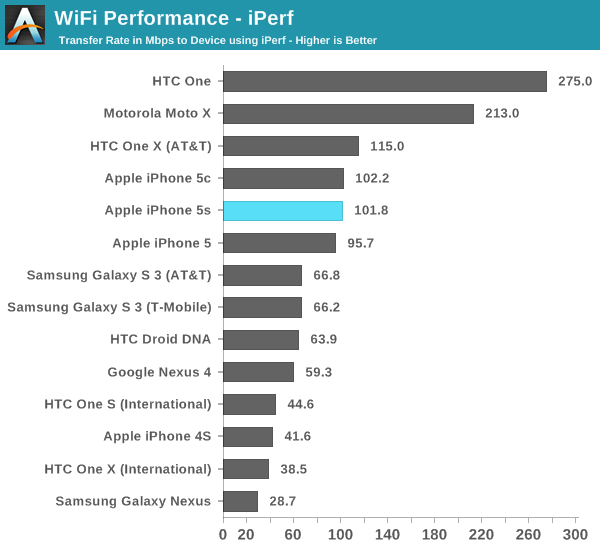
WiFi performance seems pretty comparable to the iPhone 5. The HTC One and Moto X pull ahead here as they both have 802.11ac support.













464 Comments
View All Comments
CyberAngel - Thursday, September 19, 2013 - link
Hurray!name99 - Wednesday, September 18, 2013 - link
I imagine he would say "I heard exactly the same shit about the A6 and how it couldn't possibly be as good as I claimed. Come back when you have NUMBERS to back up your complaints."monaarts - Wednesday, September 18, 2013 - link
You are mistaking a more natural transition to a 64-bit mobile world with a "PR stunt." Yes, Android will probably make a huge jump and switch to 64-bit and include 8GB of memory, or something crazy like that, but will only add to fragmentation they are already burdened with. However, Apple is trying to avoid that by building steps that lead to where they eventually want the iPhone to go.ddriver - Wednesday, September 18, 2013 - link
The PC market is fragmented as well, but is still goes, doesn't it? Surely, as a bigger ecosystem, android will be slower to adopt changes. But HPC doesn't really make sense in a phone, that is why most ARM chip vendors are focusing on server v8 chips and infrastructure, which will be more lucrative than consumer electronics. v8 is the future, no doubt about it, but apple has no other winning hand besides offering v8 a little too early, knowing they can make up for the cost of the premature transition with profit margins other manufacturers cannot dream of asking for the same hardware. Surely, other brands have their fanboys too, but nowhere nearly as fanatically devoted and eager to "just take my money".tbrizzlevb - Wednesday, September 18, 2013 - link
I've never had any problem with this "fragmentation" that you cut and pasted from somewhere. How exactly has that kept you from buying Android? Do you normally keep your phone for 5 years or more? I'd be willing to bet you aren't using an iPhone 3 right now.. If you upgrade your phone every few years anyways, what do you care if the first generation Droid doesn't run the latest OS update?AaronJ68 - Wednesday, September 18, 2013 - link
The fact that there was never an iPhone 3 might have something to do with that.CyberAngel - Thursday, September 19, 2013 - link
As a programmer I say there is a HUGE fragmentation problem with all the Androids.I code for Jelly Beans only and I do have an "old" 4.0 mono CPU device for testing the lag.
Focher - Wednesday, September 18, 2013 - link
You lost me when you used the phrase "apple fanboys" and "declining sales". You don't seem to understand the difference between market share versus unit sales.ddriver - Wednesday, September 18, 2013 - link
So you must have taken "apple fanboys" personally, and understandably "declining sales" in a context regarding apples conflicts you. Like all other vendors, apple sales drop, thus the periodic refreshes, which do need their selling points, this time around it is v8. In the past, apple resorted to similar strategies, like making exclusive deals, purchasing the entire initial batches of new generation parts, and again making up for the cost of this "innovation" with their profit margins.I don't recall any other brand which pushed kids to selling their organs, do you? If that is not fanatical fanboyism, I don't know what it is...
akdj - Thursday, September 19, 2013 - link
Weird---seems to me EVERY time an iPhone is released, it sells MORE than the previous version FASTER! In fact, it's never been surpassed by another electronic item in history...and it's sales continue to climb. News Flash! Android (High end; S4/Note/HTC 1/XPeria) also sell @ a premium and almost @ the exact price of Apple's handsets. The rest of your post is nonsense. It's not just Anand's site and review praising the performance of the A7---it's ubiquitous. Is Apple paying Ars? TechCrunch? MacRumors? WSJ? Engadget? CNet?Dude---this is one HELL of an SoC. It's so much MORE than a 64bit chess match. A company licensing and building from the ground up a CPU/GPU/IPU that matches their OS and allows the tools to developers (For Free!) in XCode so the transition is seamless! The speed of this chip is awesome. Setting themselves up early is smart---the iPad release is imminent and has competition from both sides...Microsoft and Android. With a significantly larger 'body' and area to allow for more RAM...and future releases of other ARM based products, Apple is making in-roads within the mobile sector that ONLY bozos that cherish other brands, OEMs, or otherwise have some weird bone to pick with Apple can't realize. Mind blowing. I'm brand agnostic---use OSx, Windows and even own a couple of Android devices....but to me as dismissive as you are about the A7s build and putting it in a product the size of a pack of smokes is about as silly and should I say 'ignorant' a stance as I've seen in a long LONG time.
This move by Apple is HUGE. Moore's law now attributed to mobile. Still a dual core. Still 1GB of RAM (albeit DDR3 vs DDR2)---yet doubling, tripling, sometimes quadrupling performance of the other 'off the shelf' SoCs on the market that other OEMs are using. It's no secret---Apple has been hiring and head hunting chip designers from Intel and AMD for some time now. These guys and gals are some of the brightest minds on earth....but you've got it all figured out and somehow Anand's been blinded by the conspiracy---as has EVERY other reviewer on the 'net.
Un-Believable.
J